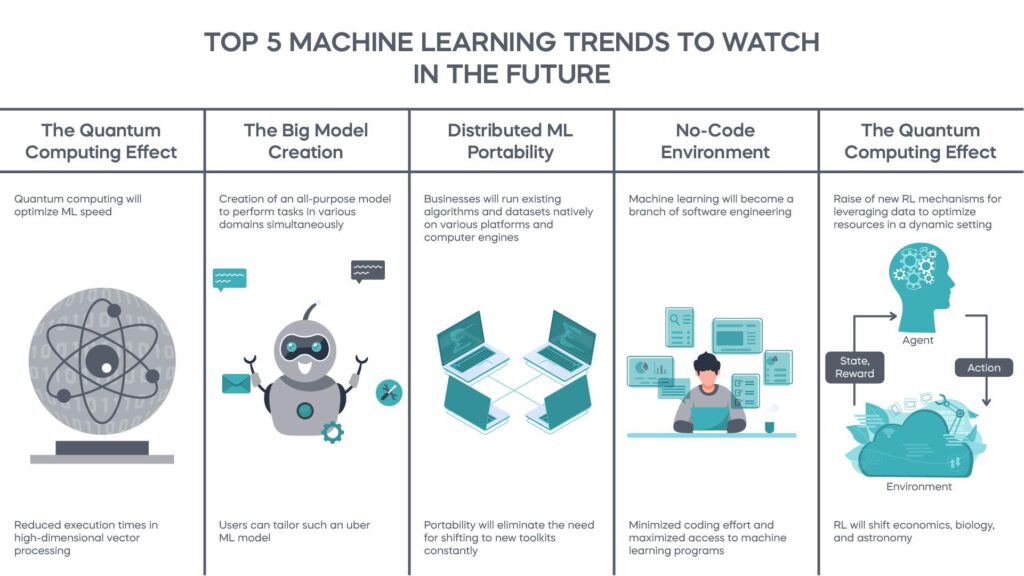Artificial Intelligence (AI) and Machine Learning (ML) are transforming industries and redefining the way we interact with technology. As these fields continue to evolve, they promise even greater advancements that will shape the future in unprecedented ways. In this blog, we’ll explore the current state of AI and ML, emerging trends, potential applications, ethical considerations, and what the future holds for these transformative technologies.
Current State of AI and ML
AI and ML have already made significant strides in various domains:
Natural Language Processing (NLP)
NLP has improved dramatically, enabling machines to understand and generate human language with increasing accuracy. Applications like chatbots, virtual assistants, and translation services have become commonplace.
Computer Vision
Advancements in computer vision have enabled machines to interpret and analyze visual information. This technology powers facial recognition, autonomous vehicles, medical imaging, and more.
Predictive Analytics
ML algorithms analyze vast amounts of data to make predictions and informed decisions. This capability is used in finance, healthcare, marketing, and many other fields.
Robotics
AI-driven robots are becoming more sophisticated, capable of performing complex tasks in manufacturing, logistics, healthcare, and even household chores.
Emerging Trends in AI and ML
The future of AI and ML is shaped by several emerging trends that promise to push the boundaries of what these technologies can achieve.
1. Edge AI
Edge AI involves processing data on devices at the edge of the network, rather than relying on centralized cloud servers. This approach reduces latency, enhances privacy, and improves real-time decision-making capabilities. Applications include autonomous vehicles, smart cameras, and industrial IoT devices.
2. Explainable AI (XAI)
As AI systems become more complex, the need for transparency and interpretability grows. Explainable AI aims to make AI decisions understandable to humans, enhancing trust and accountability. This is particularly important in fields like healthcare, finance, and law, where AI decisions can have significant consequences.
3. AI Ethics and Governance
As AI permeates various aspects of society, ethical considerations and governance frameworks are becoming crucial. Issues like bias, fairness, transparency, and accountability are being addressed to ensure responsible AI development and deployment.
4. Quantum Computing and AI
Quantum computing promises to revolutionize AI and ML by solving complex problems that are currently intractable for classical computers. While still in its infancy, quantum computing could dramatically accelerate AI research and applications.
5. Autonomous Systems
The development of fully autonomous systems, including self-driving cars, drones, and robots, is advancing rapidly. These systems rely on sophisticated AI and ML algorithms to navigate and interact with their environments safely and efficiently.
6. AI in Healthcare
AI is poised to revolutionize healthcare by improving diagnostics, personalized medicine, drug discovery, and patient care. AI algorithms can analyze medical data to identify patterns, predict outcomes, and recommend treatments with unprecedented accuracy.
7. AI and Creativity
AI is increasingly being used in creative fields such as art, music, and literature. Generative models like GPT-3 and DALL-E demonstrate AI’s ability to create original content, raising intriguing possibilities for human-AI collaboration in creative endeavors.
Potential Applications of AI and ML
The future of AI and ML will be marked by their integration into a wide range of industries and applications:
1. Healthcare
– Personalized Medicine: AI can analyze genetic data to tailor treatments to individual patients, improving outcomes and reducing side effects.
– Predictive Analytics: AI models can predict disease outbreaks, patient deterioration, and treatment responses, enabling proactive healthcare measures.
– Medical Imaging: AI-powered tools can assist radiologists in detecting abnormalities in medical images, improving diagnostic accuracy.
2. Finance
– Fraud Detection: AI algorithms can analyze transaction patterns to detect and prevent fraudulent activities in real-time.
– Algorithmic Trading: AI-driven trading algorithms can analyze market data and execute trades at high speeds, optimizing investment strategies.
– Customer Service: AI chatbots and virtual assistants can provide personalized customer support, enhancing user experience.
3. Transportation
– Autonomous Vehicles: Self-driving cars and drones rely on AI to navigate and make real-time decisions, promising safer and more efficient transportation.
– Traffic Management: AI can optimize traffic flow in cities, reducing congestion and improving transportation efficiency.
– Logistics: AI-powered systems can optimize supply chain operations, from inventory management to route planning.
4. Education
– Personalized Learning: AI can tailor educational content to individual students’ needs, enhancing learning outcomes.
– Automated Grading: AI systems can grade assignments and exams, providing timely feedback to students and reducing the burden on educators.
– Learning Analytics: AI can analyze student data to identify at-risk students and recommend interventions to improve their performance.
5. Entertainment
– Content Recommendation: AI algorithms power recommendation engines on platforms like Netflix, Spotify, and YouTube, enhancing user engagement.
– Game Development: AI is used to create realistic and adaptive game environments, improving player experiences.
– Content Creation: AI can assist in generating scripts, music, and visual effects, pushing the boundaries of creativity.
Ethical Considerations
The rapid advancement of AI and ML brings several ethical challenges that must be addressed to ensure responsible and beneficial use of these technologies:
1. Bias and Fairness
AI systems can inadvertently perpetuate and amplify existing biases present in training data. Ensuring fairness and addressing bias in AI models is crucial to prevent discrimination and ensure equitable outcomes.
2. Transparency and Accountability
The “black box” nature of many AI models makes it difficult to understand how decisions are made. Developing explainable AI and establishing accountability mechanisms is essential to build trust and ensure responsible use.
3. Privacy and Security
The use of AI often involves collecting and analyzing vast amounts of personal data. Ensuring data privacy and security is paramount to protect individuals’ rights and prevent misuse of information.
4. Job Displacement
The automation of tasks through AI and ML could lead to job displacement in various industries. Developing strategies for workforce retraining and ensuring inclusive growth is necessary to mitigate the impact on employment.
5. Ethical AI Development
Establishing ethical guidelines and governance frameworks for AI development is essential to ensure that AI technologies are used responsibly and for the benefit of society.
The Road Ahead
The future of AI and ML holds immense potential for innovation and transformation across industries. As these technologies continue to evolve, several key developments are expected to shape their trajectory:
1. Continued Advancements in Deep Learning
Deep learning, a subset of ML, will continue to drive breakthroughs in AI capabilities. Advances in neural network architectures, training techniques, and computational power will enable more sophisticated and accurate AI models.
2. Integration of AI with Other Technologies
AI will increasingly be integrated with other emerging technologies such as IoT, blockchain, and edge computing. This convergence will create new opportunities for innovation and enhance the capabilities of AI applications.
3. Expansion of AI Research
AI research will continue to expand, with a focus on addressing current limitations and exploring new frontiers. Areas such as unsupervised learning, reinforcement learning, and transfer learning will see significant progress.
4. Human-AI Collaboration
The future will see a greater emphasis on human-AI collaboration, where AI systems augment human capabilities and assist in decision-making. This collaborative approach will enable more effective and efficient outcomes across various domains.
5. Ethical AI Development
Ensuring ethical AI development and deployment will remain a priority. Policymakers, researchers, and industry leaders will work together to establish guidelines and standards that promote responsible and beneficial AI use.
Conclusion
The future of artificial intelligence and machine learning is bright, with the potential to revolutionize industries and improve our daily lives. By harnessing the power of AI and ML, we can unlock new possibilities, drive innovation, and address some of the world’s most pressing challenges. However, it is essential to navigate this journey responsibly, addressing ethical considerations and ensuring that these technologies are developed and deployed for the greater good. As we look ahead, the possibilities are boundless, and the impact of AI and ML will undoubtedly shape the future in profound ways.

